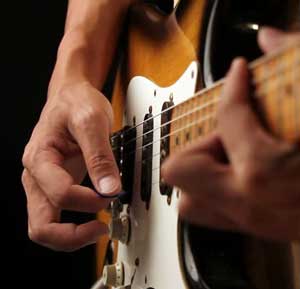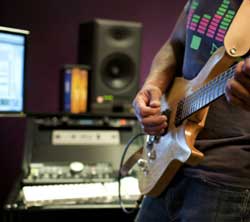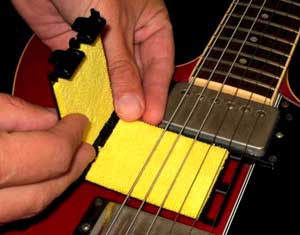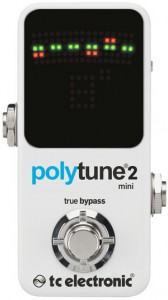To get the most out of your practice sessions, there are some things that should be part of your practice routine. While you may already do some of these things, making sure you do all five in each practice session will help you develop your skills faster.
To get better results from your practice sessions, check out this guide on how to plan your guitar practice routine.
1. Tune Up Your Guitar
This might sound obvious, but as a guitar teacher, I regularly see students start playing with an out-of-tune guitar and not seeing the problem.
Playing an in-tune guitar is crucial to your ear’s development. Over time, your ears get used to the pitch of the notes you play and learn to accept them as correct.
This means if you practice on an out-of-tune guitar (even slightly out-of-tune), your ears will start to think that those out-of-tune notes are actually in tune! Then if anybody tells you you’re out-of-tune, you won’t believe them.
You definitely don’t want that to happen.
This is such a simple thing to do, but from now on whenever you pick up your guitar, do a quick check to make sure your guitar is in-tune.
Have a tuner handy so you don’t have any excuses. Either use a pedal if you play electric guitar (like the very popular PolyTune as shown to the right), or use a clip-on tuner on an acoustic.
Many modern amps have inbuilt tuners so there really should be no excuse for not tuning up before you start a practice session.
Make it part of your routine and your ears will develop correctly each practice session.
Learn all the methods of tuning your guitar in this guide.
Check out the Best Guitar Tuners in this guide here.
2. Use Warm-Up Exercises
As soon as you sit down to practice, you might want to dive right into a song or start jamming over a backing track. Those things are fun and warm-up exercises aren’t fun. But warm-up exercises are worth the time and effort.
Running through a few finger dexterity exercises before you move on to the ‘real stuff’ helps prepare your fingers. They also help improve your picking and fretting accuracy.
You’ve probably seen an exercise like the below before:

This exercise is talked about in so many lessons for a very good reason – it does a great job at warming your fingers up and improving your technique.
Run through the above exercise a few times when you sit down to practice and you’ll be far better prepared for any difficult riffs or licks you want to work on.
If you’ve never seen the above exercise before, find out more about it and more simple warm-up exercises in this guide.
3. Challenge Yourself

When I ask new students to describe how they currently practice, they often tell me they “just play”.
Their thinking is that you don’t need a structured practice routine and you don’t need to work on exercises and drills and you don’t need to push yourself. Instead, they think you just need to play and you’ll get better.
It’d be great if that were true, but real development only happens when you push yourself.
Humans are excellent at adapting to their situation. So if you always play simple songs and never push yourself, your skills will always stay at a level where those songs continue to feel comfortable. You will plateau.
If you push yourself with challenging licks, chords, and exercises, you will gradually adapt until those challenging parts are no longer challenging. In other words, when you push yourself, you get better.
If you want to make real progress on guitar, you need to push yourself. Progress only happens when you reach slightly past your comfort zone.
Here are some ways you can challenge yourself in a practice session:
- Work on a scale in a position you’re not used to (learn how to practice scales here)
- Try learning a complicated lick, solo or riff (here are some simple riffs to get started)
- Create chord progressions with chords you don’t normally play
- Use a metronome to practice something at a higher tempo than you’re used to
- Try to figure out a song’s chord, riff or lick by ear (learn about playing by ear here)
- Try learning a style of music completely outside of what you usually play
If it feels hard at first, that’s a good sign it’s worth working on. What feels hard today can only feel easy in the future if you work on it.
It would be nice if we could all pick up the guitar as beginners and become a virtuoso, but to become a great guitarist takes effort.
In every practice session, try to push past your comfort zone and try something you’ve never attempted before or something you’ve failed at before.
My Bite-Size Guitar Podcast regularly covers ways you can challenge yourself. If you ever feel stuck on guitar or need new ideas, have a listen to the short episodes.
4. Listen Back To Your Playing

The first time I record my students and play their performance back to them, they’re always shocked at what they hear. They suddenly notice mistakes, poor timing, and awful tone they didn’t notice while playing.
This is similar to hearing your voice on a recording – it doesn’t sound like what you hear when you speak, but it is you.
What’s happening here is that while you’re playing, you’re focusing on different things.
You might be focusing on technique, timing, or remembering what note comes next. Because your attention is usually focused on what you need to play, you’re unable to also focus on how you sound.
It’s only when you hear a recording of your playing that your mind is free to truly listen.
Recording yourself during a practice session then listening back to the recording is one of the most powerful things you can do to improve.
A simple way to record yourself is with a looper pedal. A looper can instantly record anything you play and play it back for you. Check out the Best Looper Pedals in this guide to find one that suits your needs.
So let’s say you record yourself playing something. What should you do with that recording?
Here are some things to listen for and think about when you listen back to the recording:
- Were there any mistakes or problems with what you played?
- Was the timing correct or off?
- How could you improve the phrasing of what you heard?
- Does the recording sound like you’re playing in a relaxed, tense, or rushed state?
- What did you do really well in the recording? How can you take that across to other areas of your playing?
- What should you focus on when you play the part again?
Thinking about these questions helps you become a better guitarist. It’s important to be critical of your playing because nobody is perfect.
The chances are you didn’t play that part flawlessly, so take the opportunity to look for areas for improvement.
If you can’t find anything wrong with your playing, upload a clip to YouTube and you’ll get plenty of people telling you what you did wrong 🙂
If I could name one thing that most guitarists don’t do that could have the biggest impact on their progress, it would be this point.
Learn more about why you should record your playing here.
If you want to start creating high-quality recordings of your music, learn everything you need to know about recording guitar at home here.
The guide covers all the hardware and software you need to record guitar as well as tutorials to get you started.
5. Wipe Down Your Strings

This is such a simple thing to do but not everybody does it. Have a cloth handy so when you’ve finished your practice session, use it to wipe down your strings.
Not only does this extend the life of your strings, but it keeps your fretboard clean from dirt and grime buildup.
If you really want to keep things clean you can use something like the Fingerease Guitar String Lubricant.
It does a good job at removing the oils from your fingers on the strings. The String Cleaner as shown to the right is also a handy option rather than using a cloth. They do the same thing so use whatever you prefer.
When you wipe your strings down, make sure you slide the cloth underneath the strings to remove any buildup in-between the strings and frets.
If you’ve never done this before, you might be shocked by how much gunk comes off the strings.
Simply wiping down your strings can make a big difference in how long they last. If you find that your strings wear out really quickly, you might want to consider getting a different type that lasts longer.
Find out everything you would want to know about guitar strings such as metals used, gauges, coatings, windings, and more in this guide: Ultimate Guide to Guitar Strings.
Of course, there are plenty of other things you could do in your practice sessions, but the above five points are simple areas I feel a lot of guitarists are neglecting. Add these five things into your practice routine and you’ll gradually notice a change in how much you get out of each practice session.
Read through this guide on Setting Up An Ideal Practice Space for more tips and advice to get the most out of your practice sessions.
If you want to practice when you’re away from your guitar, read this guide on How to Practice Guitar Without a Guitar. Practicing the six things covered in the guide will help you grow as a guitarist.
Finally, find out how long to practice guitar in this guide. How long you practice plays a massive role in how fast you will develop your guitar skills. The guide explains the science-based principles to work out the optimal time to practice guitar each day.

